Tabagisme et peau
Dr Christophe Hsu – dermatologist. Geneva, Switzerland
Viral Wart (verrucae vulgaris or common wart)
What causes warts ?
- Warts are harmless skin growths caused by a virus. They can grow on any part of the body, like on the face, along the forearms or on the finger. Warts have a rough surface on which tiny, dark dots can often be seen. On pressure areas like the palms or the soles, they appear flat. Warts on the sole (called plantar warts) grow inward from the pressure of standing and walking and are often painful.
- Warts are common and can be a nuisance. They may bleed if injured. Common warts never turn cancerous. Warts are contagious, and may spread from one part of the body to another or to other children. We don’t know why some people get warts while others don’t. There is no way to prevent warts.
- Warts often disappear by themselves, especially in young children. This spontaneous disappearance is less common in older children and adults.
- Warts on the genitals are usually sexually acquired.
- There is no perfect treatment for warts, since we are unable to kill the wart virus. Treatment consists of destroying the outer layer of skin where the wart grows on. This can be done by surgery, laser ablation, electrocautery (destroying with a weak current), by freezing (with liquid nitrogen) or with chemicals like salicylic acid. The treatment to be used depends on the location and size of the warts and the judgement of the dermatologist. Sometimes new warts will form while existing ones are being destroyed. All we can do is treat the new warts when they become large enough to be seen.
- No matter what treatment is used, warts occasionally fail to disappear. They may return weeks or even months after an apparent cure. Don’t be concerned if a wart recurs; just consult your dermatologist for further therapy. The treatment may be repeated, or a different method may be used to get rid of the warts.
Liquid Nitrogen Treatment
- Liquid nitrogen treatment (cryotherapy) is the commonest treatment method for warts. Your wart and the surrounding skin can be treated with liquid nitrogen, a very cold substance. Liquid nitrogen, when applied to the skin, usually results in blister formation similar to a burn. The wart is lifted and it will fall off when the blister dries. You may experience some pain which should be easily controlled with simple pain killers.
- There is no need to cover the treated areas if the blisters are intact. However, if these blisters are very large and tense, they may be pricked with a needle sterilized in a flame. A simple dry dressing may also be applied.
- At least a week must lapse between treatments, even if a blister does not form.
Contributors
Dr Christophe Hsu – dermatologist. Geneva, Switzerland
National Skin Centre. Singapore
Related posts


